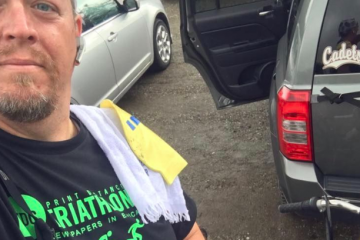We don’t expect babies to run before they can walk…
 I was asked recently about why charities aren’t utilising digital channels more to attract new donors for this article and found myself pondering, as is often the case, about how charities can best get over the barriers standing in the way of their digital fundraising.
I was asked recently about why charities aren’t utilising digital channels more to attract new donors for this article and found myself pondering, as is often the case, about how charities can best get over the barriers standing in the way of their digital fundraising.
I’ve realised that the fact that question was in the context of digital is only important from the point of view of where we are now, because what I’m about to say relates just as much to anything that has ever gone before as well as anything else that is new – digital or otherwise.
In my experience, the main barriers for fundraisers that see the need to diversify their donor acquisition into digital seem to be:
• Getting investment when you can’t accurately predict the return
When investment is made based on achieving a certain cost per acquisition, year one, two or three net income or return on investment – or whichever performance indicator you use as a benchmark – should you invest in something where you don’t know what that will be, or how do you make the argument that doing so is worthwhile?
• Making the case that new channels should be piloted when others have already been tried, tested and proven and are ‘working’ to some extent
I see this most with direct mail acquisition, where results have generally been in decline for the last few years, but charities are continuing to invest in the medium because, even though response rates are continually dropping and cost per acquisition rising, results still tend to fall within certain parameters and so are somewhat more predictable than something totally unknown.
• Getting started when you don’t have experience, skills and infrastructure
 With digital, it is often the case that there is not an existing digital donor journey, digital response handling, thanking and stewardship, good quality donation process, ability to create appeal pages or tailor landing and donation pages, and that there is not a track record in house of using web analytics, tracking, measuring and evaluating results.
With digital, it is often the case that there is not an existing digital donor journey, digital response handling, thanking and stewardship, good quality donation process, ability to create appeal pages or tailor landing and donation pages, and that there is not a track record in house of using web analytics, tracking, measuring and evaluating results.
At some point, you could have said all of these things about direct mail, about press advertising, about pretty much any donor acquisition activity that is now commonplace. No one was born with the idea of setting up a supporter services department, knowing they needed a database, donation processing, thank you letters, a donor development plan, and all of the other things most charities have in place now to enable their donor acquisition activity to succeed and flourish. But most charities have the skills and abilities to deliver most of this in some shape or form now and this has been the case for long enough that it’s all too easy to feel like it was always the case. And, for many people, the digital equivalents seem so complicated that the inertia of sticking with what they know, coupled with the risk of it not performing, is stronger than doing anything about it.
There isn’t a simple answer to any of this and it will not be solved over night for any charity that still has the journey into digital to make. So, I often talk to those charities about taking ‘baby steps’, and learning a little bit at a time and, having just seen my baby daughter do just that over recent months, the analogy is all the more meaningful to me now than before.
I realised a few days ago that everything she did from birth was in preparation for walking. Those weeks of trying to lift her head up, of learning to roll over, learning to push herself up on her elbows, the long process of getting strong enough to sit and then to push herself up to sitting on her own, of using her arms to pull herself across the carpet, while she pushed with her legs, finally finding her knees and learning to crawl, starting to pull herself up to standing using the furniture and taking first steps holding our hands or her baby walker – all of these things have been part of the process. There has been lots of limbering up, too, repeating movements over and over again – including like her baby push ups – to strengthen muscles and gain balance. And we have watched her test her limits – what happens if I lean forwards while I’m doing this, how far can I reach up or how much can I lean over the edge of the bed without losing my balance? – seen her develop coping strategies and adjust her tactics for different scenarios.
Along the way, I realised that, while we watch over her, guide her, remove hazards and prevent accidents, that we can’t ‘wrap her in cotton wool’ and she actually has to make a few mistakes in order to learn. So, we let her climb things, provided the risk is low and, naturally, there have been a couple of falls, a few bumps and some tears, but they have passed quickly and, within moments, she is up and trying again.
 Amber turned one last Friday. She has not walked on her own yet, but she has stood up a couple of times unaided and it won’t be long before she feels confident enough to take her first steps. When she does, it will be tentative. She won’t just jump up and run across the room. She will take a step and sit down again, and she’ll try it again, then add another step and, gradually, she will string it all together and start to toddle. After some practice, the toddle will be a walk and then, when she has mastered that, she will run. We never expected her to do all of this in one go – she wouldn’t have been capable. And she wouldn’t have been able to do it without stumbling, experimenting, learning, lots of practice and hard work.
Amber turned one last Friday. She has not walked on her own yet, but she has stood up a couple of times unaided and it won’t be long before she feels confident enough to take her first steps. When she does, it will be tentative. She won’t just jump up and run across the room. She will take a step and sit down again, and she’ll try it again, then add another step and, gradually, she will string it all together and start to toddle. After some practice, the toddle will be a walk and then, when she has mastered that, she will run. We never expected her to do all of this in one go – she wouldn’t have been capable. And she wouldn’t have been able to do it without stumbling, experimenting, learning, lots of practice and hard work.
I’m very honoured to be speaking at a great event this Thursday, organised by SOFII, called ‘I Wish I’d Thought of That’, and I’ve chosen to focus on a fabulous fundraising initiative that is great in large part because the charity has stuck with it, experimented, learned, practiced and worked hard at making it great – because most things don’t start great or become great over night.



7 Comments
Rachel Beer · May 29, 2012 at 15:20
Shortly after this was published, I came across this post via Twitter, which makes a similar point and includes some great tips for opening yourself up to ‘mistake making’ and all of its benefits: How many mistakes have you made today?
Paul Nazareth ( twitter @UinvitedU ) · May 29, 2012 at 15:21
A VERY good point Rachel – consultants and peers (*embarassed cough/feet shuffle* me included ) can get a little preachy about joining the social media bandwagon. Sorry about that.
Part of it is that we want our favourite brands to come out and play, to let us promote and connect them to more supporters.
Your post describes a really healthy method of responsible growth and managing risk. We love our beloved charities, why bang them up?
Loved it. P
Rachel Beer · May 30, 2012 at 00:10
Thanks for the comment, Paul. Yes, responsible growth and risk management is about the size of it. It doesn’t sound very sexy, but it’s very necessary! ;)
Tara Lepp · May 29, 2012 at 15:27
Great analogy Rachel. I think all too often charities are afraid to try something new for fear of failing but you can start off slowly off dipping your toes into the pool before you jump in with both feet.
Rachel Beer · May 30, 2012 at 00:02
Thanks Tara. I was worried about turning people off with my baby story, but the analogy struck me so powerfully the other day that I hoped it would make sense to others.
Joel Voysey · May 29, 2012 at 23:35
What a great piece and lovely to see the pictures of Amber too!
This should be recommended reading for Chief Execs, FD’s and Fundraising Directors, particularly the message that it is precisely when channels ARE working well that investment in new funding streams should be made. We’ll see huge change in our sector in the next few years, partly because of a growing reliance on statutory funding, and if we rely too heavily on one strand of our voluntary income mix we risk similar exposure.
Rachel Beer · May 30, 2012 at 00:07
Thanks for the comment, Joel. I’m glad the post resonated and I agree entirely with your point about piloting and testing new fundraising activities and developing new income streams while other channels are still working hard enough to keep the income rolling in while you’re learning. Also agree on the point about statutory funding cuts – I see lots of charities suffering now because of their over-reliance on that source of income and, the annoying thing is, you could see that one coming but still people were paralysed by the fear of trying something else and now they don’t have the budget to. Any organisations that still do, must.